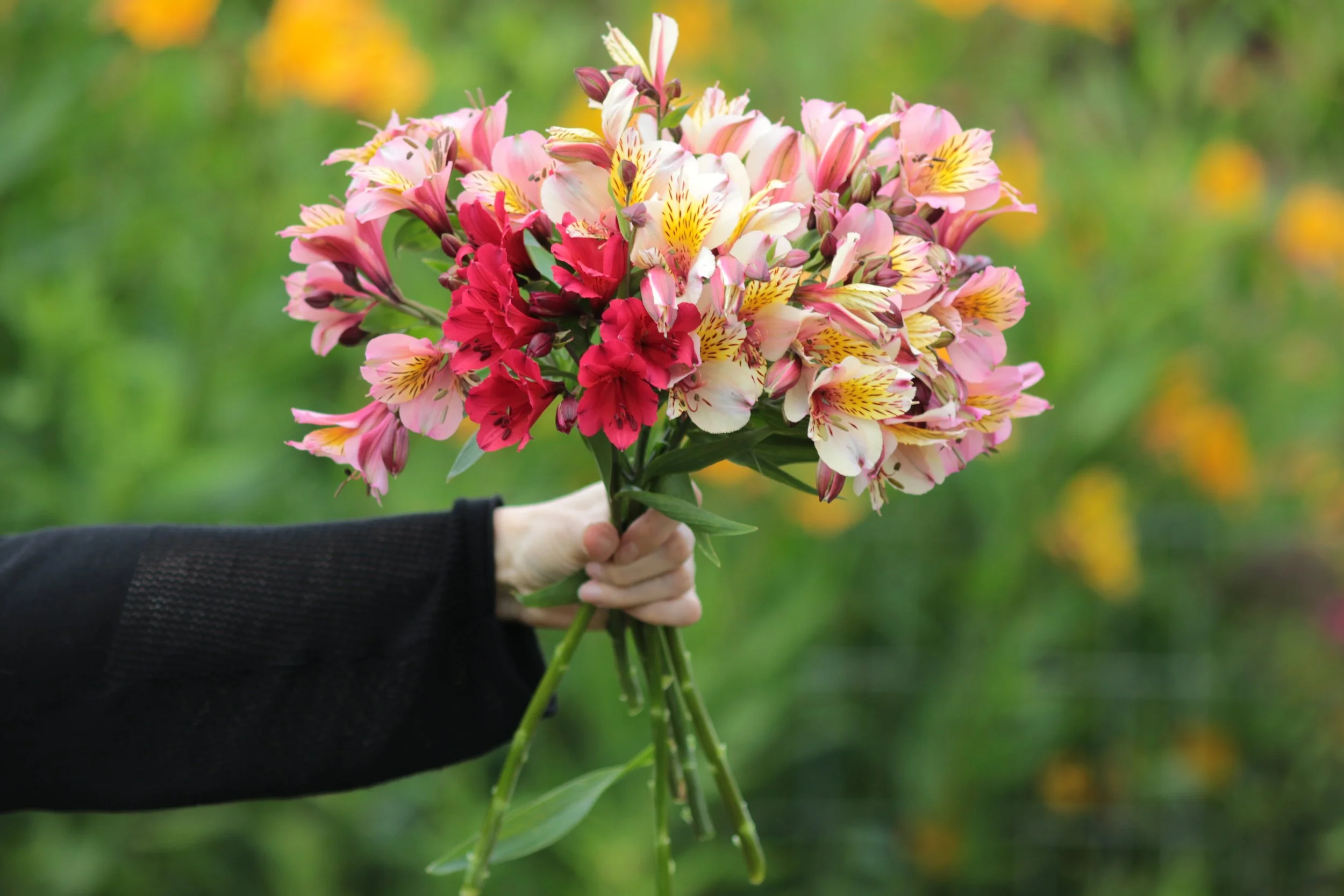Making the Cut
Floral favorites to grow and pick
Peruvian lily (Alstroemeria) makes a showy bouquet all on its own. Photo by Genevieve Schmidt
While most gardeners find themselves with numerous flowering shrubs to enjoy outside, flowers that last in a vase without exploding their petals all over the carpet or drooping dramatically hours after being cut are a somewhat rarer breed. Though tricks abound to extend the life of flowers in a vase, the most important element in a successful homegrown bouquet is selecting the right plant. Here are some favorites for every Humboldt garden.
Cutting flowers for the shade
While so many classic cut flowers require full sun, if you’re gardening in the shade of redwoods, don’t despair; you still have numerous options for a bouquet.
Bridal wreath (Francoa ramosa) is an old-fashioned shade flower that takes even dry shade once established. It develops a wide tuft of foliage at the base, and sends up slender wands of airy white flowers that can be up to 3 feet tall. F. appendiculata is another option if you prefer pink blooms. A long summer bloom season and good vase life makes them a great partner to dramatic cut foliage or larger blooms.
Astilbes bloom in late spring to early summer, and if treated kindly (spent flowers removed, watered regularly, and given good soil conditions), may rebloom again in mid-summer. They do well in bright shade, and are one of my favorite vase companions to old-fashioned David Austin roses. Lavender-pink ‘Amethyst’, reddish-pink ‘Fanal’, peachy ‘Europa’, and white ‘Deutschland’ offer many color options, and you can create an ombre effect in the vase by layering the different shades.
Hydrangeas of all kinds are a classic cut flower, blooming late summer through fall. You can even dry the blooms for vase fillers through the winter. Bigleaf Hydrangeas are the most shade-tolerant in our climate, and for cutting gardens, I like to select recently-bred varieties that bloom on both new and old wood for the longest possible flowering season. The Endless Summer line have been particularly successful, with ball-shaped ‘Blushing Bride’ in white, ‘Summer Crush’ in vivid pink, and the ‘Endless Summer’ for that classic light blue shade.
Ferns are also a solid pick. Native deer fern (Struthiopteris spicant) is a petite fern which offers two leaf textures from its fertile and evergreen fronds. Holly fern (Cyrtomium falcatum) has dramatic spiky leaflets in a glossy lime-green color.
California native cutting flowers
Native buckwheat varieties like red buckwheat (Eriogonum grande var. rubescens), nude buckwheat (Eriogonum nudum), and coast buckwheat (Eriogonum latifolium) are all low-care, drought tolerant choices for the cutting garden. In shades from white to bright pink, these pollinator magnets are best planted in autumn to catch the winter rains, and left unwatered during our summer dry season. With loosely ball-shaped flowers on a long bare stem, they are ideal for vases.
Native yarrow (Achillea millefolium) is another long-lasting cut flower. With crisp white umbels reaching 3-4 inches across, this makes a dramatic addition to a bouquet. They do make the vase water murky overnight, so add a few drops of bleach to your vase water to counteract this. This is another drought-tolerant plant that will do well without summer water if established in autumn.
California poppies (Eschscholzia californica) are an unexpected addition to a vase. Our classic orange state flower is boldly beautiful, and there are also fun varieties such as ‘Apricot Chiffon’, ‘Thai Silk Fire’, and ‘Buttermilk’ to bring other colors into the mix. Cut the stem when the flowers are colored buds, and those flowers will open, last for 3-4 days, drop their petals, and the next round of buds on the stem will open, giving you a week-long show.
Classic flower garden picks
Peruvian lily (Alstroemeria) are sold commercially by florists and valued for their exceptionally long vase life. ‘Indian Summer’ is a well-behaved, midsized variety with bronze-colored foliage and cantaloupe-colored blooms. ‘Creamsicle’ has a gorgeous pinky-beige shade that reminds me of the recently popular ‘Café Au Lait’ Dahlia, yet it’s less of a snail magnet. ‘Margaret’ is a rich magenta that seems to play well with most other flower colors.
‘Caradonna’ meadow sage (Salvia nemorosa ‘Caradonna’) is a not only has gorgeous, spiky purple blooms, but the stems are a dramatic dark brown, making it a modern-looking contrast to other cut flowers. It’s a little looser and taller than other meadow sage varieties, making it easy to cut long flower spikes. It’s also a bee magnet in the garden; they are frequently visited by our gentle native bumblebees.
David Austin roses are a great choice for roses in our climate. Bred in England where the climate is more similar to ours here in Humboldt, these have proven remarkably resilient. With most roses I try to veer towards those with fewer than 35 petals to avoid the flowers rotting on our overcast days, but with Austin roses, I find even those with somewhat fluffier flowers do beautifully. ‘Golden Celebration’ is strongly fragrant and has rich yellow blooms; ‘Desdemona’ is white with a pinkish hue, and has a fun cupped bloom shape; ‘Lady of Shalott’ is a true apricot with a gently spiced fragrance.
Genevieve Schmidt (Lic #986304) is a landscape designer and owns a fine landscape maintenance firm in McKinleyville, CA, specializing in the routine and skilled care of landscaped garden beds, such as pruning, weeding, raking, drip irrigation maintenance, as well as design and new plantings. See her work at www.GenevieveSchmidtDesign.com, and contact her via email or phone at gen@northcoastgardening.com or (707)822-2075 to discuss scheduling new plantings or a spring garden refresh.

